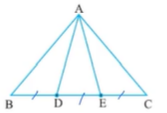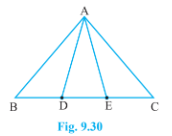D and E are two points on BC such that BD = DE = EC. Show that ar (ABD) = ar (ADE) = ar (AEC). Can you now answer the question that you have left in the ‘Introduction’ of this chapter, whether the field of Budhia has been actually divided into three parts of equal area?

Area of triangle=12×base×height
Since BD=DE=CE
∴ bases of all three triangles are equal.
Let BD=DE=CE be x
Construct altitude AP ,∴AP⊥BC
Area of △ABD=12×BD×AP=12×x×AP
Area of △ADE=12×DE×AP=12×x×AP
Area of △AEC=12×EC×AP=12×x×AP
Since the areas of all 3 triangles is equal i.e 12×x×AP
Hence the field of Budhia has been actually divided into three parts of equal area
Topper's Solved these Questions
Similar Questions
In Fig. 30 D and E are to points on BC such that BD=DE=EC. Show that ar(ABD)=ar(ADE)=ar(AEC).
View SolutionIn Fig. 9.30, D and E are two points on BC such that BD = DE = EC. Show thatar (ABD) = ar (ADE) = ar (AEC). Can you now answer the question that you have left in the Introduction of this chapter, whether the field of Budha has been actually divided into three parts of equal area ?
 View Solution
View Solution
Knowledge Check
- Question 1 - Select One
In △ABC, P is the mid-point of BC and Q is the mid-point of AP. Find the ratio of the area of △ABQ and the area of ∠ABC. The following are the steps involved in solving the above problem.
A) We know that a a median of a triangle divides a triangle into two triangles of equal area.
B) ⇒Ar(△ABP)=12[Ar(△ABC)]
C) Ar(△ABQ)=12[Ar(△ABP)]=14[Ar(△ABC)]
D) ⇒(△ABQ):Ar(△ABC)=1:4AABCDBADBCCABCDDADCB - Question 2 - Select One
In ΔABC, D and E are points on AB and AC respectively such that DE||BC and DE divides the ΔABC into two parts of equal areas. Then ratio of AD and BD is
A1:1B1:√2−1C1:√2D1:√2+1 - Question 3 - Select One
These questions consists of a question and two statements numbered I and II given below it. You have to decide whether the data provided to the statements are sufficient to answer the question. Read both the statements and select the appropriate answer
Among five people -A,B,C,D and E sitting around a circular table facing the centre, who is sitting second to the left of D ?
I. C is second to the left of A,B and D are immediate neighbours of each other.
II. D is the immediate left of B. E is not an immediate neighbout of D and BAThe data eighter in Statement I and II together are necessary to answer the questionBThe data either in Statement I alone or in Statement II alone are sufficient to answer the question.CThe data in Statement I alone are sufficient to answer the question, while the data in Statement II alone are not sufficient to answer the question.DThe data in Statement II alone are sufficient to answer the question, while the data in Statement I alone are not sufficient to answer the question.
In a Δ ABC , D and E are two points on BC such that BD : DE : EC = 4 : 5 : 6 If the area of ΔADE=30cm2. find area of ΔABC
View SolutionIn this section, you are required to spot errors in sentences. Each sentence is divided into three parts. Read each sentence to find out whether there is an error in any of the parts. No sentence has more than one error. Some of the sentences do not have any error. When you find an error in a sentence, the letter indicated under that part of the sentence is the answer and therefore the same may be marked on the separate Answer Sheet. If there is no error in any part, then (d) which stands for "No error" is the answer for the item.
That was very dangerous: (a)/you might (b)/have been killed. (c)/ no error (d)View SolutionIn this section, you are required to spot errors in sentences. Each sentence is divided into three parts. Read each sentence to find out whether there is an error in any of the parts. No sentence has more than one error. Some of the sentences do not have any error. When you find an error in a sentence, the letter indicated under that part of the sentence is the answer and therefore the same may be marked on the separate Answer Sheet. If there is no error in any part, then (d) which stands for "No error" is the answer for the item.
I wanted to see(a)/ that whether they(b) had actually read the notes.(c)/ No error (d)View SolutionIn this section, you are required to spot errors in sentences. Each sentence is divided into three parts. Read each sentence to find out whether there is an error in any of the parts. No sentence has more than one error. Some of the sentences do not have any error. When you find an error in a sentence, the letter indicated under that part of the sentence is the answer and therefore the same may be marked on the separate Answer Sheet. If there is no error in any part, then (d) which stands for "No error" is the answer for the item.
She inquired whether(a)/ anyone (b)/ has seen (c) her baby. / no error (d)View SolutionThese questions consists of a question and two statement numbered I and II given below it. You have to decide whether the data provided in the statement are sufficient to answer the question. Read both the statements and select the appropriate answer.
Among five people - A , B , C , D and E around a circular table facing the centre , who is sitting second to the left of D
I. C is second to the left of A. B and D are immediate neighbours of each other.
II. D is to the immediate left of B. E is not an immediate neighbour of D and B.View Solution

